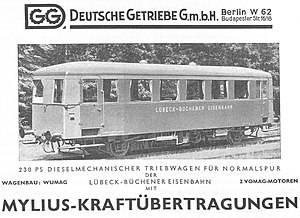LBE VT 11
| LBE VT 11 | |
|---|---|
|
LBE VT 11
|
|
| Numbering: |
LBE : VT 11 DR 821 |
| Number: | 1 |
| Manufacturer: | WUMAG Görlitz |
| Year of construction (s): | 1936 |
| Retirement: | unknown |
| Type : | AA dm |
| Genre : | CvT |
| Gauge : | 1435 mm ( standard gauge ) |
| Length over buffers: | 13,260 mm |
| Length: | 12,200 mm |
| Height: | 3,640 mm |
| Width: | 3,120 mm |
| Total wheelbase: | 7,000 mm |
| Service mass: | empty: 19,268 kg occupied: 24,760 kg |
| Wheel set mass : | 9,910 kg |
| Top speed: | 85 km / h |
| Installed capacity: | 2 × 85 kW (2 × 115 PS) |
| Wheel diameter: | 880 mm |
| Motor type: | 2 × VOMAG GR 1060 |
| Motor type: | 2 × six-cylinder four-stroke diesel engines |
| Rated speed: | 1,800 rpm |
| Power transmission: | mechanical with Mylius gear |
| Tank capacity: | 130 l |
| Brake: | Compressed air brake type Knorr |
| Seats: | 56 + 3 folding seats |
| Floor height: | 1,350 mm |
| Classes : | 3. |
The LBE VT 11 multiple unit was procured by the Lübeck-Büchener Eisenbahn (LBE) for operation on its non-electrified routes, starting from Lübeck . The railcar was taken over by the Deutsche Reichsbahn with the number 821 in 1938 and is no longer available today.
history
The modernization plan of the Lübeck-Büchener Railway not only included vehicles for high-speed express traffic. It was important to improve the local traffic in Ostholstein in terms of motorization. As early as 1934, the company had acquired a small railcar with a trailer from the Uerdingen wagon factory for operation on the Lübeck-Segeberger Railway . Experience with this led to the ordering of larger vehicles for coaching operations, of which the VT 11 mentioned here, the other the VT 12 manufactured in the Uerdingen wagon factory . Both cars were built according to the same basic principles, but differed in terms of technical details and appearance. A sidecar that was almost identical in appearance was also purchased with the VT 11, but the VB 111 was three meters shorter than the railcar, had 43 seats and a toilet.
The VT 11 was delivered in the summer of 1936. Scheduled use began in 1937. The vehicles were used in the Lübeck depot . With the takeover of LBE by the Deutsche Reichsbahn , the vehicles remained in Lübeck. In December 1940 they were part of the DR. In 1943 they were taken over by Altlandsberger Kleinbahn AG . The further use of the VT 11 is unknown.
Constructive features
The railcar was created according to the same specifications as the VT 12. The interior and exterior design is the work of the Bertsch architectural office in Berlin . Both vehicles differed in a few details in the design. The VT 11 was a little shorter than the car from the Uerdingen wagon factory and had revolving doors at the ends of the vehicle. Since the floor was higher than that of the Uerdinger Wagen, the VT 11 had an additional step in the entry area. The upholstered tubular steel seats could be folded down depending on the direction of travel and were covered with leather. The block-braked wheel sets were designed as club steering axles and cushioned against the car body by leaf springs with single hooks.
The car body was made as a welded box frame and sheet metal as a frame construction. The body tapered at the ends of the car. A vestibule was separated from the passenger compartment on one side, which served as a luggage room and to accommodate bicycles. In total, the passenger compartment had 56 seats and three folding seats. It was heated by an underfloor heating system with an externally charged hot water oven to which four radiators were connected. The car, like the Uerdingen car, had headlights below the buffer beam. The reason was the possibility of better recognizability of distant beacons in fog.
The two machine systems were arranged below the floor. They each consisted of a six-cylinder four-stroke diesel engine from VOMAG and an associated Mylius gearbox and were mounted on a common support frame with rubber springs to the main frame. The drive axles were driven by the transmission with a cardan shaft. The reversing gears were also arranged on the drive axles. The engine system used could be determined from the driver's cab through a pneumatically operated engine selection group. Usually both systems were used together.
literature
- Alfred Gottwaldt : The Lübeck-Büchener Railway , Alba-Verlag, Düsseldorf 1975, ISBN 3-87094-235-5 .
- Heinz Kurz: Railcar of the Deutsche Reichsbahn , EK-Verlag, Freiburg 2013, ISBN 978-3-88255-162-4 .
Web links
- Website about the vehicles of the Lübeck-Büchener-Eisenbahn with the mention of the VT 11
- Discontinuation of LBE traction vehicles
- Database with mention of the LBE VT 11
See also
Individual evidence
- ^ Alfred Gottwaldt : Die Lübeck-Büchener Eisenbahn , Alba-Verlag, Düsseldorf 1975, ISBN 3-87094-235-5 , page 97
- ↑ Gerd Wolff: German small and private railways. Volume 12: Schleswig-Holstein - eastern part . Eisenbahn-Kurier, Freiburg 2011, ISBN 978-3-88255-671-1 , p. 135 .
- ↑ a b Heinz Kurz: Railcar of the Deutsche Reichsbahn , EK-Verlag, Freiburg 2013, ISBN 978-3-88255-162-4 , page 213
- ↑ data sheet of the LBE vehicles
- ↑ a b P. Mauck: Diesel-mechanical railcar of the Lübeck-Büchener railway. In: Verkehrstechnik , born 1936
- ^ Alfred Gottwaldt : Die Lübeck-Büchener Eisenbahn , Alba-Verlag, Düsseldorf 1975, ISBN 3-87094-235-5 , page 99
